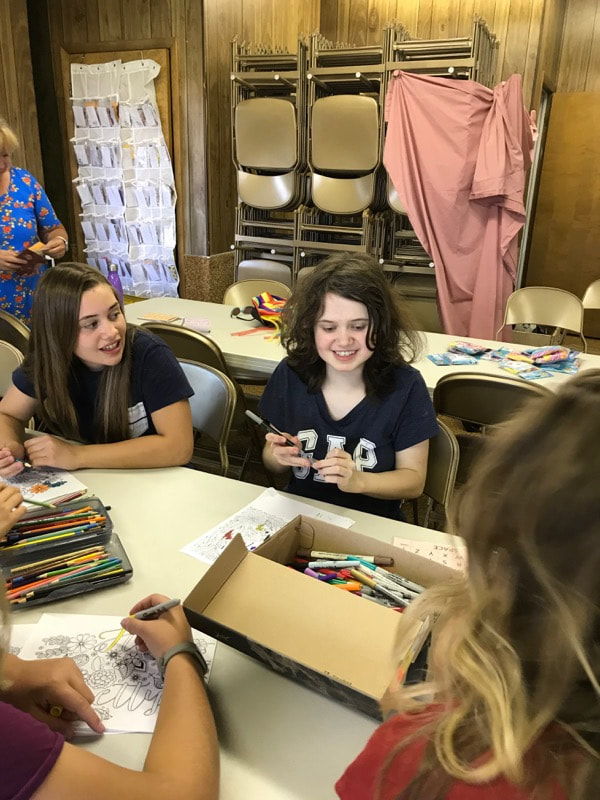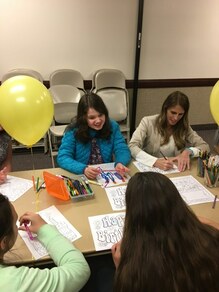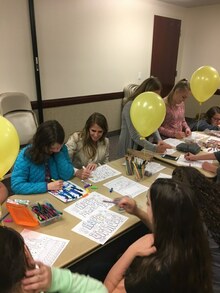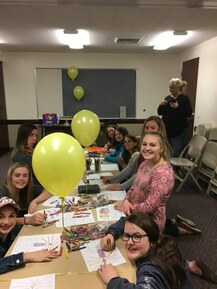|
"Therefore all things whatsoever ye would that men should do to you, do ye even so to them"
Matthew 7:12 |
Tips for Inclusion
The following are different ideas to include a variety of individuals in different situations in a religious environment and community:
INCLUSION: Many families are trying to just make it to church and be able to stay. It might require some outreach so families know you really care and are going to make each effort to be there for them. Typically, it is ideal to include individuals with their age group. Inclusion means they are part of the group, not simply in the same room. This can be a challenge when an individual is easily overloaded sensory wise or the individual can't sit. Different plans to build up the sensory tolerance (handle the environment) for a situation with a group can be put in place until they can handle the group the whole time.
If it is just a matter of movement, sometimes all can stand and have a non-traditional Sunday School.
Here are 2 examples of inclusion. First, is music time and the second is in a church girl's camp:
If it is just a matter of movement, sometimes all can stand and have a non-traditional Sunday School.
Here are 2 examples of inclusion. First, is music time and the second is in a church girl's camp:
|
|
|
ANSWER QUESTIONS: It is important that everyone's voice is heard. Provide options for the individual to answer questions about facts, their thinking, and opinions. See 'Teaching' for how to do this.
VISUAL AIDS: Pictures, objects and videos clips can be a useful teaching tool particularly for those who aren't able to read. Be mindful that some individuals may struggle with the visual stamina to look at the visuals. Watch for rubbing the eyes, pushing the visual away, intentionally turning the head away as possible indicators of visual fatigue. (Default to more auditory means like describe a picture or tap the choices as a way to accommodate for visual fatigue or not not looking.)
PRESENTATIONS-ROLE PLAYING-PRAYERS: If an individual is an unreliable speaker, sometimes they will be able to read out loud fine, so other than practice and preparing, they are good to go if you have a script. Most will not be able to read out loud. They will need a different way of participating. One way is to record their message on a device that can play it for them. There are a number of free or inexpensive apps for iPads or iPhones that can be download. All the individual has to do it touch it and it will play it for them. Usually bigger areas are ideal for those with poor motor skills. This can be used for: reading a scripture, skits, presentation part, role playing, prayers, etc.
Here is an example of one:
Here is an example of one:
|
|
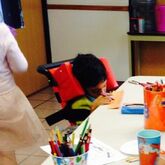
ART PROJECTS:
Some will color with everyone else. Others it will be a struggle. If class members are drawing, you can give them options to pick from of what they want help drawing or what they want you to draw for them. You might have a peer do it with them. For those who have use of their hands, start with having them just do a little bit with the group. You can explain that sometimes it is important to do what others are doing so we can be part of the team. I found with one child, counting as he colored helped to motivate him to participate. I told him he needed to color until I counted to five. Then I'd have him change the color and count to a different amount. Eventually he would count on his own. (If you try this you might focus first on just doing it once and then call it good.) If a student can't move, then you can take their hand and color or draw with them for a sensory experience. You can deliver options as noted above. You might need to watch facial expressions for them to indicate what they want to have you draw for them. Suggestions for the visually impaired are listed here. |
|
|
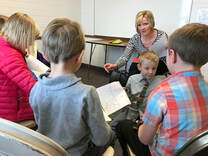
SERVICE:
If you can give them ways to serve, then you give the individual a way to lead. They can hold up pictures for the class, pass out papers, stack or put out chairs etc. Allowing them to serve their peers also breaks the ice and allow for more interactions, which are vital for all involved. They might need help doing these things. A teacher or peer can be asked to help them or do it with them.
If you can give them ways to serve, then you give the individual a way to lead. They can hold up pictures for the class, pass out papers, stack or put out chairs etc. Allowing them to serve their peers also breaks the ice and allow for more interactions, which are vital for all involved. They might need help doing these things. A teacher or peer can be asked to help them or do it with them.
|
|
HOME VISITS: In cases where the family has determined they are not able to come to church for the present or the individual has severe medical needs. It is ideal to set up a plan to keep them in the loop and uplift them. This can include peers as well as teachers and leaders.
Ideas to Include Outside Church Meetings or Outreach:
1-Throw them a birthday party-find out their likes and dislikes. Plan according to the individual's wants, desires, and comforts. These do not have to be long or traditional in nature. They can take place in a home or church, etc. (Below, peers and leaders from Cindi's congregation threw her a party on her 16th birthday! They are doing one of her favorite activities with her--coloring!)
2-Plan activities that allow peers and leaders to get to know the individual and that allow all to serve together or each other. Plan activities periodically that fit that individual's interest.
3-Make a healthy treat (check to know if the individual has dietary restrictions) and take it over to them. Talk to them and maybe share an uplifting message.
4-Peers or leaders could go over to their home and read to them or place games. They might learn some simple task they could do to help the individual function and develop hobbies--then teach the individual them.
5-Can provide respite for the families and individual to give them little breaks.
3-Make a healthy treat (check to know if the individual has dietary restrictions) and take it over to them. Talk to them and maybe share an uplifting message.
4-Peers or leaders could go over to their home and read to them or place games. They might learn some simple task they could do to help the individual function and develop hobbies--then teach the individual them.
5-Can provide respite for the families and individual to give them little breaks.
|
"I AM SO BLESSED TO HAVE KIND FRIENDS. THEY HELP ME IN ACTIVITIES. THEY WATCH OUT FOR ME. THEY UNDERSTAND MY MELT DOWNS. I AM NOT AT CHURCH MUCH BUT I LIKE THEY HAVE ROOM FOR ME. I AM NOT JOKING—THEY TRY." -Cindi, Age 17, Utah |
|
|
|
"THE ISOLATION OF NONVERBAL PEOPLE IS REAL. I AM NOT SURE IF I SHOULD SAY WHAT I THINK. I DON'T BELIEVE IT CAN BE TOTALLY SOLVED. WHAT I CAN SAY IS IT IS REALLY IMPORTANT TO TALK LIKE WE HEAR. KEEP TALKING TO US LIKE WE UNDERSTAND. BE BRAVE AND KIND IN ACTIONS EVEN WHEN NOT POPULAR. I LOVE BUT I GET HURT WHEN OTHERS DON'T SHOW RESPECT WHEN IT IS NOT COOL." -Soumil, Age 13, California |
